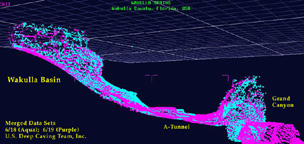 | |
           2026 Sistema Cheve |
Wakulla 2 Technology
Computer Graphics On the Wakulla-2 Expedition surveying is done automatically by a Digital Wall Mapper (DWM) mounted on a Diver Propulsion Vehicle (DPV). The DWM uses an Inertial Navigation System (INS) for determining the position and orientation of the DPV and a Sonar Measurement Device (SMD) that simultaneously measures thirty-two wall distances for determining cross sections. Data are gathered several times per second and the resulting wall points are spaced tens of centimeters apart. Within the DWM, data from the INS, the SMD, three pressure sensors, and a thermometer are stored in an on-board computer. When the DPV returns to the surface the data are downloaded to a Personal Computer (PC). The PC reformats and writes the data to a zip disk which is then transferred to a Silicon Graphics Inc. (SGI) workstation. Nine separate programs, written in ANSI C and using SGI-GL for graphics support, comprise the software suite on the SGO workstations. These nine programs provide the following functions:
About 50,000 lines of custom C-code are required to perform these functions. |
| Copyright © 2025 U.S. Deep
Caving Team, Inc. All rights reserved. Todo el contenido tiene derechos de autor del U.S. Deep Caving Team. Todos los derechos reservados. No portion of these pages may be used for any reason without prior written authorization. | |

